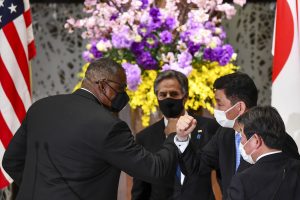Last month, the top diplomatic and defense officials from Japan and the United States met in a U.S.-Japan Security Consultative Committee (2+2) meeting. Foreign Minister Motegi Toshimitsu and Defense Minister Kishi Nobuo met with Secretary of State Antony Blinken and Secretary of Defense Lloyd J. Austin III. The meeting came immediately on the heels of the Japan-Australia-India-U.S. Leaders’ Video Conference held on March 12, in which a shared vision of a “free, open and inclusive Indo-Pacific” based on universal values and without the use of the power to intimidate was presented to the world.
The Japanese media mostly focused on the two nations’ criticism of China by name in their reporting of the 2+2. According to the reports, the two nations recognized that China’s actions were inconsistent with the existing international order, which presents political, economic, military and technological challenges to the alliance and international community, and that both sides also expressed serious concerns about recent disruptive developments in the region, such as the China Coast Guard Law.
It was also widely reported that the U.S. and Japan agreed to conduct joint military exercises for the defense of the Senkaku Islands. In statements, the two nations said they remained opposed to any unilateral actions that undermine Japan’s administration of the Senkaku Islands, and reiterated the need for bilateral and multilateral practical exercises and training to maintain operational readiness and the deterrent posture of the Japan-U.S. alliance, and to meet future challenges.
The following points may highlight the significance of the meeting. The first is that Japan was able to draw a commitment from the Biden administration to its relationship with Japan. During the Trump administration, the personal relationship between former President Donald J. Trump and former Prime Minister Abe Shinzo was an important pillar in the Japan-U.S. relationship, so it was a significant achievement for the government of Suga Yoshihide to be able to show to both domestic and international audiences that the Biden administration is also committed to the Japan-U.S. relationship.
The meeting was also a success for the Biden administration, which was able to present its stance on the deterrence of China to its ally, Japan, under circumstances where the specific military and diplomatic policies of the new U.S. administration had yet to be properly unveiled.
The second point is that Japan and the United States affirmed their strong support for ASEAN’s unity and centrality and the ASEAN Outlook on the Indo-Pacific. Both nations pledged to work with ASEAN. This is important in light of the geopolitical focus of the U.S.-China conflict being in Southeast Asia and the relationship between China and Southeast Asia growing closer recently.
The Trump administration did not address challenges regarding the U.S. commitment to ASEAN. It is important for the region that the Biden administration strengthen these ties, among other commitments such as the East Asia Summit (EAS).
The third point is that, given South Korea’s unclear position on the Free and Open Indo-Pacific strategy (FOIP) Initiative, the statement “Trilateral cooperation among the United States, Japan and the Republic of Korea is critical for our shared security, peace and prosperity in the Indo-Pacific region” is important in clarifying the relationships between Japan, the U.S., and South Korea and may serve as a message to South Korea. However, the connection between FOIP and the North Korea question was not sufficiently explained.
These positive outcomes notwithstanding, the meeting highlighted challenges in the Japan-U.S. alliance. Although there was agreement on conducting joint Japan-U.S. military exercises for the defense of the Senkaku Islands, other practical actions were not incorporated into the statement, and only a rough direction for the future was presented. This is profoundly related to the part of the joint statement of the U.S.-Japan Security Consultative Committee (2+2), which stated “The Ministers acknowledged the importance of close coordination as the Department of Defense conducts its Global Posture Review.”
Currently, the United States Department of Defense’s China Task Force is leading a review of Washington’s China strategy. Although the Japan-U.S. alliance is naturally closely linked to this matter, a continuous review is necessary to make clear how the alliance will be involved and the roles it will be able to play. In other words, the significance of the meeting was not the provision of a conclusion but the indication of a beginning of the two nations’ relationship as the Japan-U.S. alliance moves forward under the Biden administration.
One way of looking at the 2+2 meeting is that a selection of items for future consideration was put on the table. What becomes of these items going forward is now the critical question. In that sense, the greatest achievement of the meeting may be the commitment to practical work going forward to bolster the alliance. Indeed, the two nations agreed to call for another meeting of the Security Consultative Committee later in the year, to confirm progress. This will require both the United States and Japan to build on the points raised in the March meeting.

































